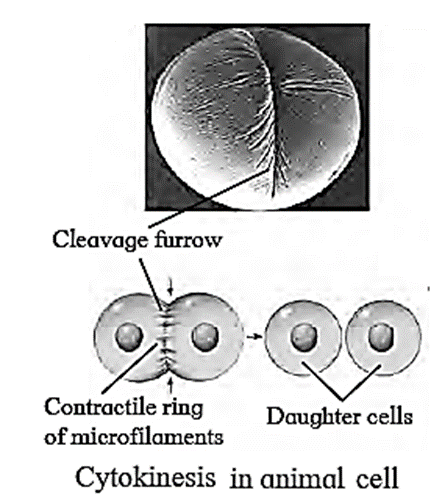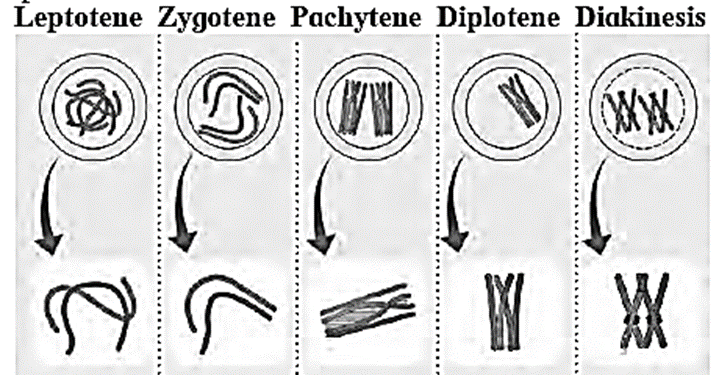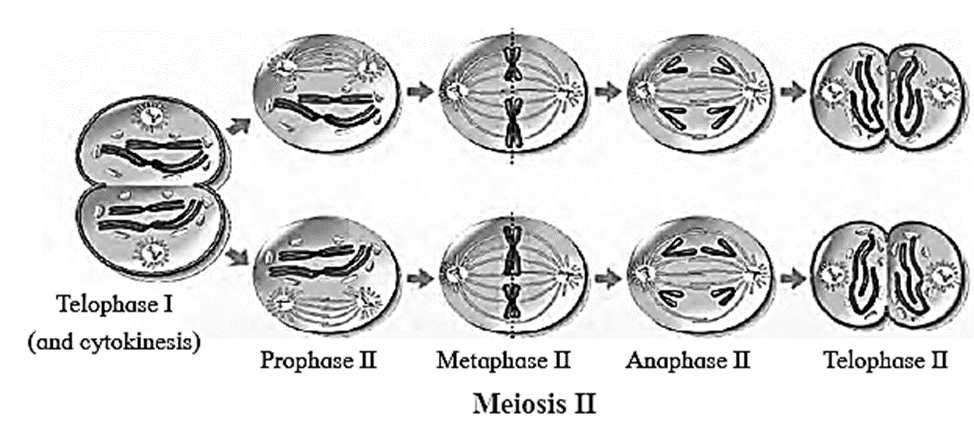Cell Divisions
Maharashtra Board-Class-11-Science-Biology-Chapter-7
Notes
|
Topics to be Learn :
|
Introduction :
Healing of wound :
- Wound is an injury to living tissue.
- Healing of wound take place by mitosis.
- Repetitive mitotic divisions near the site of injury results in healing of wound
Two types of wound-healing processes can occur, depending on the depth of the injury.
- Epidermal wound healing occurs in wounds that affect only the epidermis
- Deep wound healing occurs in wounds that penetrate the dermis.
Skin damage initiates a sequence of events that helps in repairing the skin to its normal or near-normal structure and function.
Growth : Living things show growth from within. Non-living things show growth by accumulation of materials on their surface.
Cell cycle : Click here to View Figure-1

Interphase: It is the stage between two successive cell divisions.
- It is the longest phase of a cell cycle.
- During interphase, the cell is metabolically very active.
- In this phase, a cell grows to its maximum size, chromosomal material (DNA and histone proteins) duplicates and the cell prepares itself for next mitotic division.
- Hence, interphase is known as preparatoiy phase.
The interphase is subdivided into three sub-phases as G1-phase, S-phase and G2-phase. G1- phase (First gap period/First Gap Phase): S - phase (Synthesis phase): G2- phase (Second growth phase/Second Gap Phase): During all three phases of interphase, a cell grows by producing proteins and cytoplasmic organelles such as mitochondria and endoplasmic reticulum.
M-phase or period of division : 'M' stands for mitosis or meiosis.
- M-phase involves karyokinesis and cytokinesis.
- Karyokinesis is the division of nucleus into two daughter nuclei.
- Cytokinesis is division of cytoplasm resulting in two daughter cells.
Know this :
|
G0 phase : G0 phase is considered as either an extended G1 phase in which the cell is neither dividing nor preparing to divide or a distinct quiescent stage which occurs outside the cell cycle. Cells in G0 are in non-dividing phase.
Types of cell division :
Cell division : The division of cells into two (or more) daughter cells with same (or different) genetic material is called cell division.
There are three types of cell divisions: (i) Amitosis : (ii) Mitosis: (iii) Meiosis:
Karyogram or Karyotype :
- A karyotype is a representation of condensed chromosomes arranged in pairs.
- Analysis o the karyotype of a particular individual indicates whether the individual has a normal set of chromosomes or whether there are abnormalities in number or appearance of individual chromosomes.
Karyokinesis :
Karyokmesis is the nuclear division which is divided into prophase, metaphase, anaphase and telophase.
Prophase : Click here to View Figure-2
Metaphase: [Note: The centromeres divide at the beginning of anaphase so that the two chromatids of each chromosome become separated from each other.] Click here to View Figure-3
Anaphase: Click here to View Figure-4
Telophase : Click here to View Figure-5




Cytokinesis :
Cytokinesis in animal cell : Click here to View Figure-6

Cytokinesis in plant cell : Click here to View Figure-7

Significance of mitosis :
Life span of cell :
Death of cell :
Necrosis : Necrosis is a form of cell injury which leads to the premature death of cells. For example: due to scrape or a harmful chemical.
Apoptosis : Apoptosis also known as programmed cell death or cellular suicide. In apoptosis cells die in controlled way.
- Example: during embryonic development the cells between the embryonic fingers die in a process called apoptosis to give a definite shape to the fingers.
- Apoptosis also helps in eliminating potential cancer cells.
Meiosis :
- It takes place only in reproductive cells during the formation of gametes.
- By this division, the number of chromosomes is reduced to half, hence it is also called reductional division.
- The cells in which meiosis take place are termed as meiocytes.
- Meiosis produces four haploid daughter cells from a diploid parent cell.
Meiosis is of two subtypes :
(i) First meiotic division or Heterotypic division – (Meiosis I) :
- Heterotypic division is first meiotic division, during which a diploid cell is divided into two haploid cells
- The daughter cells resulting from this division are different from the parent cell in chromosome number.
- Hence the division is called heterotypic division. .
It consists of following phases:
Prophase -I:
- It is the most complicated and longest phase of meiotic division
- It is further divided into five sub-phases viz. leptotene, Zygotene, pachytene, diplotene and diakinesis.
Click here to View Figure-8
Leptotene : Zygotene : Pachytene: Diplotene : Diakinesis :

Metaphase-I :
- The spindle fibres are well developed.
- The tetrads orient themselves on equator in such a way that centromeres of homologous tetrads lie towards the poles and arms towards the equator.
- They are ready to separate as repulsive force increases.
Click here to View Figure-9

Anaphase-I:
- Homologous chromosomes are carried towards the opposite poles by spindle apparatus. This is known as disjunction.
- The two sister chromatids of each chromosome do not separate in meiosis -I. This is reductional division.
- The sister chromatids of each chromosome are connected by a common centromere.
- Both sister chromatids of each chromosome are now different in genetic content as one of them has undergone recombination.
Click here to View Figure-10

Telophase-I: 4
- The haploid number of chromosomes becomes uncoiled and elongated after reaching their respective poles.
- The nuclear membrane and nucleolus reappear and thus two daughter nuclei are formed.
Cytokinesis-I :
- After the karyokinesis, cytokinesis occurs and two haploid cells are formed.
- In many cases, these daughter cells pass through a short resting phase or interphase / interkinesis.
Click here to View Figure-11

The association between the homologous chromosomes i.e. chiasmata remain till metaphase I. During metaphase I, the paired homologous chromosomes move to the metaphase plate. In anaphase I, the spindle fibers begin to shorten. As these spindle fibres shorten, the association between homologous chromosomes (chiasmata) are broken, allowing homologous chromosomes to be pulled to opposite poles.
Q. What is exact structure of synaptonemal complex.
Synaptonemal complexes are zipper like structures assembled between homologous chromosomes during the prophase of first meiotic division.
Q. What is structure of chiasmata?
Chiasmata are X-shaped points of attachment between two non-sister chromatids of a homologous chromosomes.
Spindle fibres :
Role of Centriole : Centriole plays an important role in cell division. Centrioles help organize icrotubule assembly and forms spindle apparatus that separate the chromosomes during cell division.
(ii) Second meiotic division or Homotypic division (Meiosis II) :
Two haploid cells formed during first meiotic division divide further into four haploid cells this division is called homotypic division.
It consists of five phases: prophase - II, metaphase — II, anaphase — II, telophase - II, and Cytokinesis — II. .
Click here to View Figure-12
Prophase — II: Metaphase — II: Anaphase — II: In this phase, the separated chromatids become daughter chromosomes and move to opposite poles due to the contraction of the spindle fibres attached to centromeres. Telophase — II: Cytokinesis — II

Significance of Meiosis :
- Meiotic division produces gametes.
- If it is absent, the number of chromosomes would double or quadruple resulting in the formation of monstrosities (abnormal gametes).
- Meiosis ensures that organisms produced by sexual reproduction contain correct number of chromosomes.
- Meiosis exhibits genetic variation by the process of recombination.
- Variations increase further after union of gametes during fertilization creating offspring with unique characteristics.
- Thus, it creates diversity of life and is responsible for evolution.
In absence of meiosis :
- Production of gametes will not take place. Gametes are essential for sexual reproduction, which are produced by the process of meiosis
- Diploid organisms have two set of chromosomes (one paternal and one maternal).
- For a diploid organism to undergo sexual reproduction it needs to create gametes that contain only one set of chromosomes so the number of chromosomes remains same in the next generation.
- In absence of meiosis, the chromosome number of parents and their offspring will differ in every generation, hence no species will hold its characters.
- Also, there will be no crossing over of homologous chromosomes. Thus, there will be no variations with respect to the changing environment in progeny to maintain their existence, which may lead to extinction of species.
Difference between meiosis — I and meiosis — II : 2-This division is called heterotypic division. 3-It consists of prophase-I, metaphase-I, anaphase-I, telophase-I and cytokinesis. 4-Number of chromosomes is reduced to half, i.e. from diploid to haploid state. 5-It is complicated and long duration division. 6-Telophase I results into 2 daughter cells. 2-This division is called homotypic (equational) division. 3-It consists of prophase — II, metaphase —II, anaphase — II, telophase — II and cytokinesis. 4-In meiosis II number of chromosomes remain the same. 5-It is simple and short duration division, Telophase II results in 4 daughter cells.
Meiosis — I
Meiosis — II
1-Diploid cell is divided into two haploid cells.
1-Two haploid cells formed in meiosis I divides further into four haploid cells
Process of recombination :
Main Page : – Maharashtra Board Class 11th-Biology – All chapters notes, solutions, videos, test, pdf.
Previous Chapter : Chapter-6-Biomolecules – Online Notes
Next Chapter : Chapter-8-Plant Tissues and Anatomy – Online Notes
We reply to valid query.